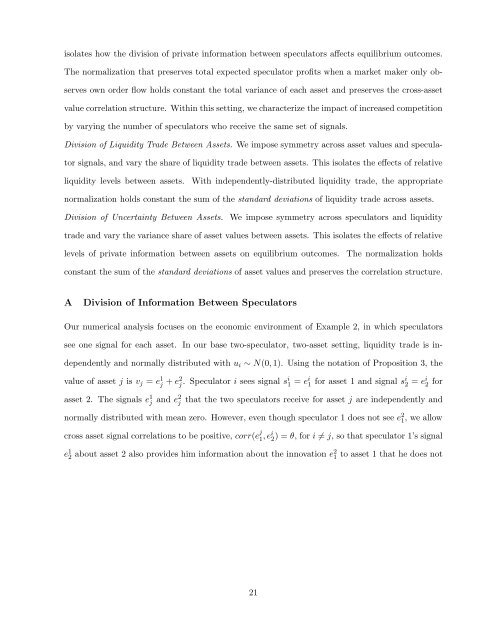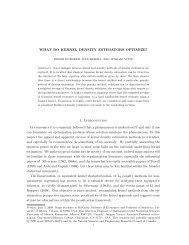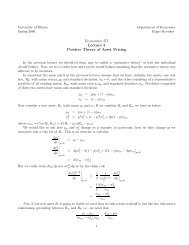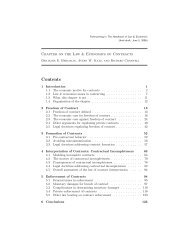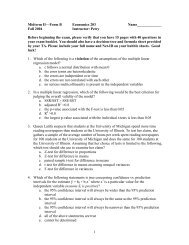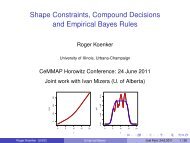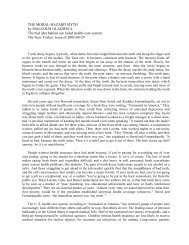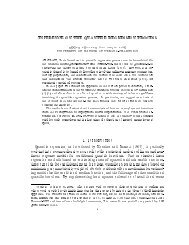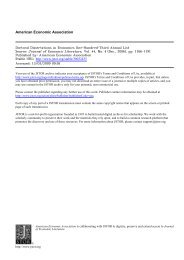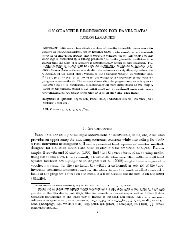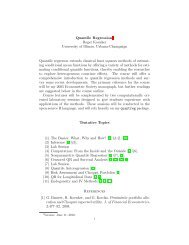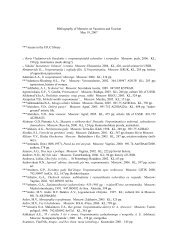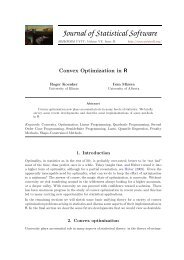Cross-Asset Speculation in Stock Markets∗ - Econometrics at Illinois ...
Cross-Asset Speculation in Stock Markets∗ - Econometrics at Illinois ...
Cross-Asset Speculation in Stock Markets∗ - Econometrics at Illinois ...
You also want an ePaper? Increase the reach of your titles
YUMPU automatically turns print PDFs into web optimized ePapers that Google loves.
isol<strong>at</strong>es how the division of priv<strong>at</strong>e <strong>in</strong>form<strong>at</strong>ion between specul<strong>at</strong>ors affects equilibrium outcomes.The normaliz<strong>at</strong>ion th<strong>at</strong> preserves total expected specul<strong>at</strong>or profits when a market maker only observesown order flow holds constant the total variance of each asset and preserves the cross-assetvalue correl<strong>at</strong>ion structure. With<strong>in</strong> this sett<strong>in</strong>g, we characterize the impact of <strong>in</strong>creased competitionby vary<strong>in</strong>g the number of specul<strong>at</strong>ors who receive the same set of signals.Division of Liquidity Trade Between <strong>Asset</strong>s. We impose symmetry across asset values and specul<strong>at</strong>orsignals, and vary the share of liquidity trade between assets. This isol<strong>at</strong>es the effects of rel<strong>at</strong>iveliquidity levels between assets. With <strong>in</strong>dependently-distributed liquidity trade, the appropri<strong>at</strong>enormaliz<strong>at</strong>ion holds constant the sum of the standard devi<strong>at</strong>ions of liquidity trade across assets.Division of Uncerta<strong>in</strong>ty Between <strong>Asset</strong>s. We impose symmetry across specul<strong>at</strong>ors and liquiditytrade and vary the variance share of asset values between assets. This isol<strong>at</strong>es the effects of rel<strong>at</strong>ivelevels of priv<strong>at</strong>e <strong>in</strong>form<strong>at</strong>ion between assets on equilibrium outcomes. The normaliz<strong>at</strong>ion holdsconstant the sum of the standard devi<strong>at</strong>ions of asset values and preserves the correl<strong>at</strong>ion structure.ADivision of Inform<strong>at</strong>ion Between Specul<strong>at</strong>orsOur numerical analysis focuses on the economic environment of Example 2, <strong>in</strong> which specul<strong>at</strong>orssee one signal for each asset. In our base two-specul<strong>at</strong>or, two-asset sett<strong>in</strong>g, liquidity trade is <strong>in</strong>dependentlyand normally distributed with u i ∼ N(0,1). Us<strong>in</strong>g the not<strong>at</strong>ion of Proposition 3, thevalue of asset j is v j = e 1 j + e2 j . Specul<strong>at</strong>or i sees signal si 1 = ei 1 for asset 1 and signal si 2 = ei 2 forasset 2. The signals e 1 j and e2 jth<strong>at</strong> the two specul<strong>at</strong>ors receive for asset j are <strong>in</strong>dependently andnormally distributed with mean zero. However, even though specul<strong>at</strong>or 1 does not see e 2 1 , we allowcross asset signal correl<strong>at</strong>ions to be positive, corr(e j 1 ,ei 2 ) = θ, for i ≠ j, so th<strong>at</strong> specul<strong>at</strong>or 1’s signale 1 2 about asset 2 also provides him <strong>in</strong>form<strong>at</strong>ion about the <strong>in</strong>nov<strong>at</strong>ion e2 1to asset 1 th<strong>at</strong> he does not21


